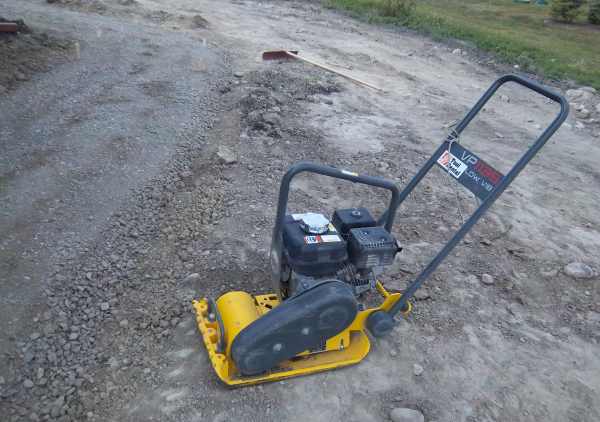E. Flagstone Patio Base Preparation
Proper patio base preparation ensures the success of your patio project.
This is your foundation which is the most important part of any
construction project.
There are many problems that can arise from a poorly prepared base that could cost you a lot of time and money, so do it right the first time.
Make sure your excavation area is free of any loose soil and debris. You should always have a hard packed subsoil, or hard clay base to start from. This is called your subsoil level.
Compaction at the subsoil level
If you are using a landscape fabric or geotextile of any kind, it is much easier to lay this down after you have compacted your sub-soil. If my subsoil base is not quite solid enough, I always use a jumping jack for further compaction. This is especially important in new construction where settling is more prone to occur.

A plate tamper will work as well, but it won't give you the same amount of compaction. I usually spread a thin layer of my gravel sub base material over the subsoil to make further compacting easier, and less dusty. A light spray of water also works well in all phases of compacting.
The equipment will also move more easily than it will over plain dirt. (This is true for power tampers more so than a jumping jack.) It will hold (bite), on the gravel better than it will on dirt.
Don't pack in any patio base when it wet, or the soil is saturated. If you build a patio on an excessively wet base, or high water table, you may end up with frost heaves in the winter or spring.
Packing in sub base
Now you have your subsoil packed in, you can pack in your required sub-base. Light watering while packing in 2 inch layers works well. These 2 inch layers are referred to as "Lifts". This will help with compaction, and keep dust down.
I use ¾ inch crushed rock with a two inch crushed aggregate on top for bedding the stones, but your landscape supplier may have recommended something different.
It is also recommended to run the vibratory plate tamper over each lift at least two to three times.
Make sure you avoid using round rocks under your patio, because they do not pack in as well. Crushed rock has mechanical bond, as the broken and jagged edges lock together better than round do.
Working with geotextiles
When you lay your fabric down overlapping at least a few inches. Leave it overlapping the edges of the patio area as well, and cut off the excess after you have installed your edge restraints.
I have pretty standard rules when working with landscaping fabric. My overlap is 4 inches minimum, and I overlap from the high end to low end in the direction of drainage. Have some landscaping pins handy, or try to have another person if it is breezy. If you have no landscaping pins, use stones.
Keeping things level and consistent
You were asked to purchase an 8 or 10 ft 2x4 in your required materials. This is going to be a helpful tool with each layer you pack.
Having two people is nice if you know how to screed, but you can still get your area level working by yourself. You will have more success building a good base working alone if you use stakes, laser levels, and string between the stakes. (These are your guides.)
Screed guides
1 or 2 inch plastic or metal piping makes it easier and more consistent in preparing your bedding material for the stones. When you lay these down, they make guides to ensure a consistent, level, and smooth layer of sand for bedding the stones.
Screed guides are very helpful, but won't have quite the same value with a flagstone patio as they do with manufactured bricks. Flagstone is not going to be consistent in thickness. Adjustments of the bedding material have to be made with each stone.
With a brick/interlock patio the bedding layer needs to be properly packed and screeded to leave a consistent bed for the bricks.
If you don't use screed guides you can still prepare the bedding material for the flagstone. It just requires a little more effort. Place a long straight board on the packed gravel base in different places. Then place a level on the board. This allows you to see how your grade is at any time, and in any direction.
It will also show you high and low spots by moving it around and checking under the board for gaps. Using a hard bow rake and a wide landscape rake will easily allow you to make adjustments to the packed base. Move the board around to show you where you need to add or remove gravel, then pack it again with your plate tamper.
Repeat these steps until you have an area that is consistent and level. Remember with your sub-base that you are going to have 2 inches of sand to bed your flagstones on, and the thickness of your stones.
You are now ready to put together the biggest jigsaw puzzle you
have ever done. In the next section, we will be explaining how to lay
flagstone.
It's time to start laying patio stones...
_____________________________________
Table of Contents: Flagstone Patio
D. Flagstone Patio Site Preparation
E. Flagstone Patio Base Preparation
F. Laying Flagstone Patio Stones
G. Flagstone Patio Edging and Jointing
H. Flagstone Patio Completion and Clean-up
______________________________________
Return to Dream Yard Home Page from Patio Base Preparation
Check out our time and money saving e-book
How to avoid the biggest mistakes made by DIYers, designers, and landscaping companies.
Visitor
Favorites
Giggles 'n' Thoughts





